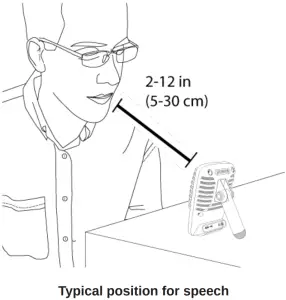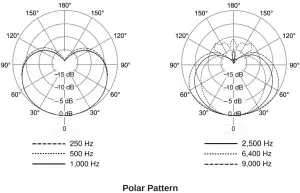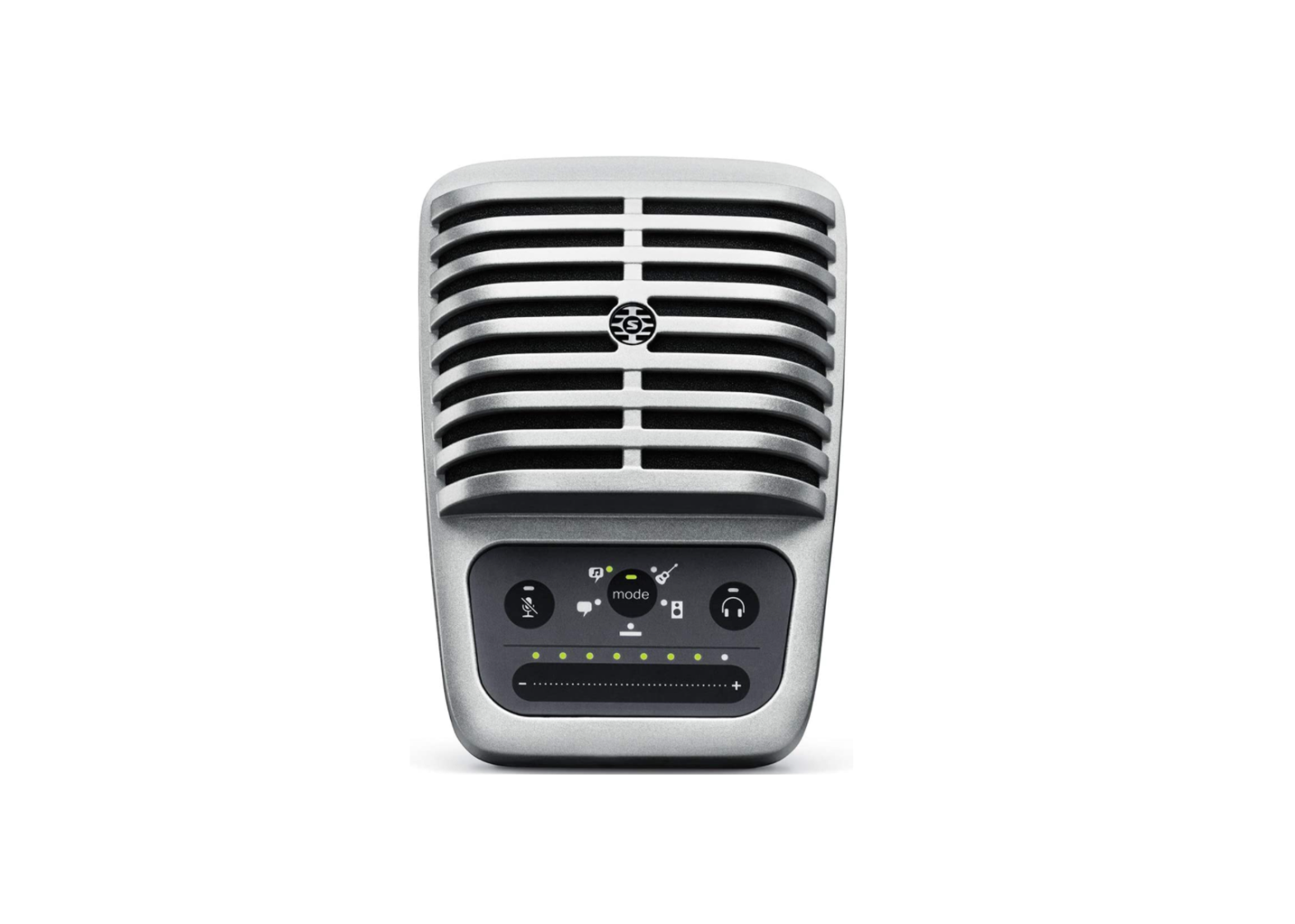SHURE MV51 Digital Large-Diaphragm Condenser Microphone
General Description
The Shure MV51 is a professional-quality USB condenser microphone, ideal for home recording, podcasting, and video conferencing. The attractive and durable all-metal design features an adjustable kickstand for desktop use, and can also mount onto a microphone stand. A touch panel user interface provides control of microphone gain, headphone level, application modes, and muting.
Features
- Easily adjust settings with the intuitive touch panel interface
- Compatible with most iDevices (iPhone, iPad, and iPod) through Lightning® interface
- Compatible with most computers, tablets and smart phones through USB interface
- Large-diaphragm electret condenser microphone captures speech and music with excellent clarity
- Sleek design includes all-metal housing for professional-grade durability
- Headphone output allows real-time monitoring of the live signal and audio from the computer or device
- Preset DSP modes include equalization and compression settings for specific applications
- Desktop kickstand includes a removable tip for mounting onto a microphone stand
Mounting and Placement
DesktopAim the microphone towards the sound source by adjusting the kickstand.
Microphone StandUnscrew the end cap to thread the kickstand onto a standard 5/8″ microphone stand.
Quick Setup
The MV51 is compatible with most devices that have a USB or Lightning connector.
- Connect the microphone to a computer or mobile device. Use the appropriate cable (USB or Lightning).Drivers will be installed automatically. The touch panel illuminates to indicate a successful connection.
- Open the sound control panel. Select the Shure MV51 driver.Raise the level on both the MV51 product and the host computer for proper monitoring.
- Confirm that the MV51 is the selected audio device.Plug headphones into the MV51 device audio output and play an audio track. If you can hear sound, the microphone is functioning properly.If your computer settings default to another device, open the sound control panel and select the MV51 device.
- Adjust the headphone volume on the Shure MV51 device driver.Open the MV51 driver from the sound control panel and raise the headphone volume from the playback or output tab.
- Use the MODE button to select the preset mode that fits your application.If the audio is too quiet or causes distortion, adjust the gain manually. Refer to the “Adjusting Microphone Level” topic in this guide for more details.
- In your recording application, select the MV51 as the input source.See your software user guide for information on assigning input sources. You are ready to record.
Touch Panel Interface Controls
① Volume Control SliderAdjust microphone or headphone level by sliding your finger across the control surface.
- Press the mode button to activate microphone level.
- Press the headphone button to activate headphone volume.
② LED barDisplays microphone and headphone level. The LED color indicates the level being displayed or adjusted.
- Green: Microphone level
- Orange: Headphone level
③ Mute ButtonPress to mute and unmute the microphone.
④ Mode SelectorPress to select preset mode.
⑤ Headphone Volume SelectorPress to select headphone level controls (orange LED bar). Then use the volume control slider to adjust headphone level. Press again to return to microphone level display (green LED bar).
Preset Modes
Five selectable modes optimize settings for gain, stereo width, equalization, and compression. Set the microphone level and try the modes to find which sounds best. Preset modes can affect the strength of the input signal, so adjust the microphone level as needed after changing presets.
| Mode | Application | Characteristics |
| speech | Narrow stereo width to reject background noise, equalization that emphasizes clarity and fullness, and gentle compression. | |
| solo or group vocal performances | Medium stereo width with subtle equalization to add richness and clarity for a natural sound. | |
| any | An unprocessed signal (no equalization or compression settings used). Adds flexibility when processing the audio after recording. | |
| acoustic instruments and quiet music | Medium stereo width with transparent compression to smooth out volume spikes and bring out quiet passages. The equalizer setting emphasizes detail and an overall natural sound. | |
| live performance and louder sources | Wide stereo to increase separation between sources. Equalization further improves definition by reducing frequencies that can make the instrumentation sound crowded. |
Advanced Mic Settings
After selecting the preset mode, fine-tune your sound with limiter, compressor, and equalizer settings. These settings are retained in the microphone when using other audio and video recording applications.
LimiterToggle the limiter on or off to prevent distortion from volume peaks in your recording.
CompressorChoose no compression, or select light or heavy compression to control volume when your sound source is dynamic. Quiet signals are boosted and loud signals are lowered.
Equalizer
Change the preset modes to hear the DSP changes, and use the equalizer to boost or cut bands of frequencies to improve sound clarity.
Note: Equalization within presets will not be displayed. However, the EQ icon in the advanced settings status bar indicates user-selected equalization. Equalization changes are displayed in the equalizer image.EQ persists between preset mode changes.
Equalization changes are displayed in the equalizer image.EQ persists between preset mode changes.
Applications
This section suggests microphone placement for typical use cases. Keep in mind that there are many effective ways to record a given source. Experiment with the following microphone placement and settings to find what works best.
Podcast and Voice Recording
Set the microphone to the Speech mode. Speak directly into the front of the microphone at a distance of 2-12 inches (5-30 cm) away. Speaking closer to the microphone results in more bass response, similar to voices on a radio broadcast. Make additional gain adjustments if necessary.
Acoustic Instruments and Music
To capture acoustic sources, such as singing, acoustic guitar, soft percussion, or other musical instruments, use a close microphone placement. Aim the microphone directly at the sound source. For a single source, such as a string instrument or a vocalist, place the microphone 6 to 12 inches (15 to 30 cm) away. For a small group or a performer who is singing and playing an instrument simultaneously, use a distance of 2 to 10 feet (0.6m to 3 m). Placing the microphone farther away results in more ambient room sound. Set the microphone to the Acoustic or Singing mode and make additional gain adjustments if necessary.
Bands and Loud Sources
To record a band with drums or amplified instruments, aim the microphone towards the group at a distance of 6 to 15 feet (1.8 to 4.6 m). Placement of the microphone depends on the size of the room, number of people, and instrument volume. If possible, walk around the room and listen to find where it sounds best.
For other loud sources, such as an electric guitar amplifier, aim the microphone at the sound source from 0-18 inches (0-45 cm) away. Set the microphone to the Band mode and make additional gain adjustments if necessary.
Bypass EQ and Compression (Flat)
To record a signal without any processing, set the microphone to the Flat mode. This mode is appropriate for any application when you want to bypass equalization and compression presets, and is ideal when applying signal processing to the recording at a later time.
Additional Tips
Shure offers additional educational publications on recording techniques for specific instruments and applications. Visit shure.com for more information.
Adjusting Microphone Level
Select the correct preset mode for your recording application. If you hear distortion or the audio is too low, adjust the microphone level in the audio or sound control panel of your computer or recording device.
Tips:
- Set the microphone level before adjusting headphone volume.
- The headphone volume does not affect the signal level sent to the computer.
- Use the volume slider on the front panel to adjust the microphone gain level.
Note: The microphone gain control is independent of the preset modes. Set your microphone level and experiment with dynamic processing options via the preset modes.
Adjusting Headphone Level
The headphone monitoring level is affected by the MV51 device level and the computer settings level. Raise your computer volume up and easily adjust headphones through the MV51 device headphone settings.
Accessing the Control Panel
PC
- Open the sound control panel and select the Recording tab.
- Open the Shure MV51 device.
- Under the Levels tab, adjust the gain level using the slider.
Mac®
- Open the Audio Midi Settings panel.
- Select the Shure MV51 device.
- Click on Input to adjust the gain using the slider.

Input Meter Level
If your digital audio workstation or recording software has input meters, adjust the microphone level so it peaks between -12 and -6 dB. Otherwise, simply listen to the audio to make sure it is loud enough and not distorting. The target range for peak levels on a typical meter is between -12 and -6 dB.
The target range for peak levels on a typical meter is between -12 and -6 dB.
Monitoring with the MOTIV Device
The headphone output provides an equal blend of the direct microphone signal and audio playback from the computer. This allows you to conveniently adjust the overall headphone volume with one control on the device touch panel. To change the playback audio level relative to the direct microphone signal level, adjust the computer or DAW mixer settings.
Tip: When first connecting the microphone to your computer, make sure to raise the volume level in the sound control panel of the computer for a strong audio signal. Then adjust headphone level on the device for comfortable monitoring.
Sampling Rate and Bit Depth
Sample Rate and Bit Depth settings are found in a drop down menu in the audio or sound control panel of your computer. You can adjust these variables to fit your needs. Select a lower sample rate for podcast recording, when it is important to have a smaller file for easy download. Select a higher sample rate for music and more dynamic recordings. Tip: Record at a higher sample rate and bounce down to an M4A for a file with the highest sound quality at a manageable size. Tip for PC users: Make sure that the sample rate and bit depth microphone settings, found in the sound control panel of the computer, match with the sample rate and bit depth selected in your software.
Troubleshooting
| Issue | Solution |
| The display does not illuminate | Make sure that the MV51 is fully plugged in. |
| Audio is too low | Check the computer sound control panel settings. When first connecting the MV51 to your computer, make sure to raise the computer volume level. |
| Audio sounds bad | Check the sound control panel of the computer to ensure that the MV51 is fully plugged in and recognized. |
| Audio is distorted | Use the audio meter to ensure that volume peaks are within the target range. If level is reaching the red peak indicator of the input meter, turn the gain down. |
| Audio sounds unnatural or jittery | Make sure that the sample rate and bit depth microphone settings, found in the sound control panel of the computer, are consistent with the sample rate and bit depth selected in your software. |
| MV51 is plugged in, but the volume meter does not register a signal. | Edit the privacy setting for the iOS device under SETTINGS > PRIVACY > MICROPHONE to give the recording application permission to use the microphone. |
| Device not working with USB hub. | The MV51 requires 250 mA per port. Check USB hub documentation for current/port specification. |
System Requirements and Compatibility
| Windows | Windows 7 and higher Minimum RAM = 64 MB USB 2.0 |
| Macintosh | OS X Lion 10.7 and higher Minimum RAM = 64 MB USB 2.0 |
| iOS | iOS 10.0 and higher |
| iPhone | iPhone 5 and higher |
| iPod Touch | 5th gen |
| iPad | iPad 4th gen and higher |
| iPad Mini | iPad Mini 1st gen and higher |
Specifications
MFi CertifiedYes
DSP Modes (Presets)Speech/Singing/Acoustic/Loud/Flat
Transducer TypeElectret Condenser (25 mm)
Polar PatternUnidirectional (Cardioid)
Bit Depth16-bit/24-bit
Sampling Rate44.1/48 kHz
Frequency Response20 Hz to 20,000 Hz
Adjustable Gain Range0 to +36 dB
Sensitivity-39 dBFS/Pa at 1 kHz [1] [2}
Maximum SPL130 dB SPL [2]
Headphone Output3.5 mm (1/8)
Power RequirementsPowered through USB or Lightning connector
Mute Switch AttenuationYes
Mounting StandBuilt-in
Stand Adapter5/8-27 thread mount (standard mic stand mount)
Housingall metal construction
Net Weight574.7 g (20.27oz.)
Dimensions128 x 86 x 70 mm H x W x D[1] 1 Pa=94[2] dB SPLAt Minimum Gain, Flat Mode


Accessories
Furnished Accessories
| 1 m USB cable | AMV-USB |
| 1 m USB-C cable | 95C38076 |
| 5/8″ to 3/8″ (Euro) Threaded Adapter | 95A2050 |
Certifications
Information to the user
This device complies with part 15 of the FCC Rules. Operation is subject to the following two conditions:
- This device may not cause harmful interference.
- This device must accept any interference received, including interference that may cause undesired operation.
Note: This equipment has been tested and found to comply with the limits for a Class B digital device, pursuant to part 15 of the FCC Rules. These limits are designed to provide reasonable protection against harmful interference in a residential installation. This equipment generates uses and can radiate radio frequency energy and, if not installed and used in accordance with the instructions, may cause harmful interference to radio communications. However, there is no guarantee that interference will not occur in a particular installation. If this equipment does cause harmful interference to radio or television reception, which can be determined by turning the equipment off and on, the user is encouraged to try to correct the interference by one or more of the following measures:
- Reorient or relocate the receiving antenna.
- Increase the separation between the equipment and the receiver.
- Connect the equipment to an outlet on a circuit different from that to which the receiver is connected.
- Consult the dealer or an experienced radio/TV technician for help.
Industry Canada ICES-003 Compliance Label: CAN ICES-3 (B)/NMB-3(B)
Note: Testing is based on the use of supplied and recommended cable types. The use of other than shielded (screened) cable types may degrade EMC performance.
This product meets the Essential Requirements of all relevant European directives and is eligible for CE marking.
The CE Declaration of Conformity can be obtained from: www.shure.com/europe/compliance
Authorized European representative:Shure Europe GmbHHeadquarters Europe, Middle East & AfricaDepartment: EMEA Approval Jakob-Dieffenbacher-Str. 12 75031 Eppingen, GermanyPhone: +49-7262-92 49 0Fax: +49-7262-92 49 11 4Email: [email protected]


Use of the Made for Apple badge means that an accessory has been designed to connect specifically to the Apple product(s) identified in the badge and has been certified by the developer to meet Apple performance standards. Apple is not responsible for the operation of this device or its compliance with safety and regulatory standards. Apple, iPad, iPhone, iPod and Lightning are trademarks of Apple Inc., registered in the U.S. and other countries. tvOS is a trademark of Apple Inc. The trademark “iPhone” is used in Japan with a license from Aiphone K.K. Mac and Lightning are registered trademarks of Apple Inc.
References
[xyz-ips snippet=”download-snippet”]


